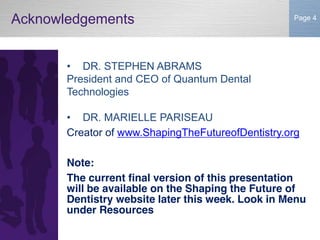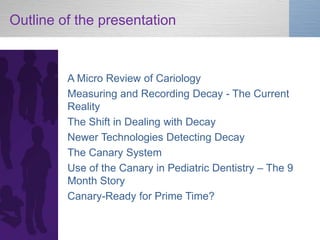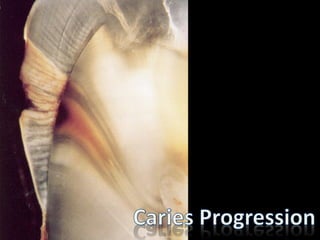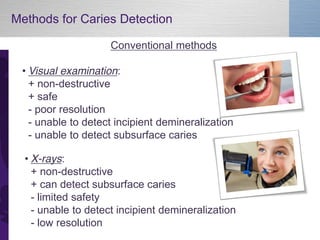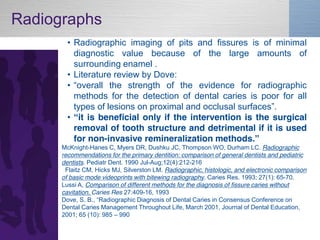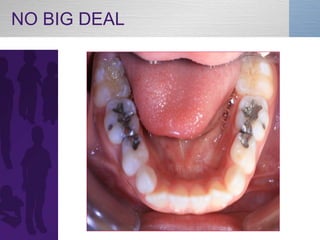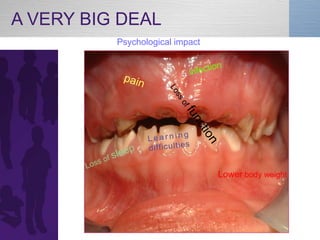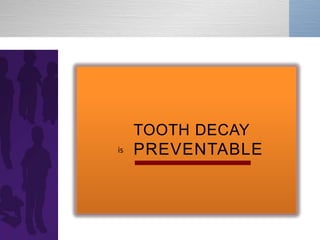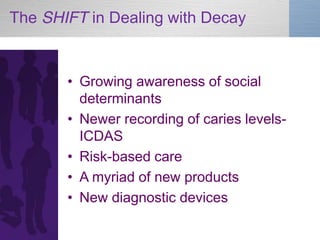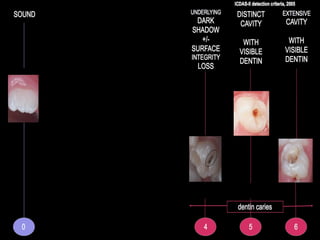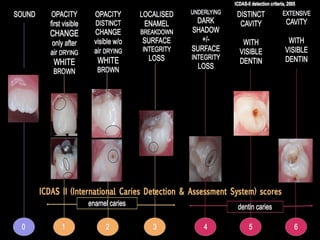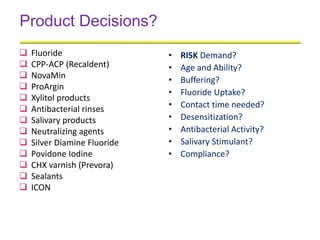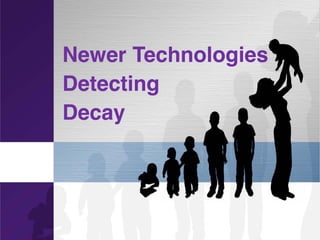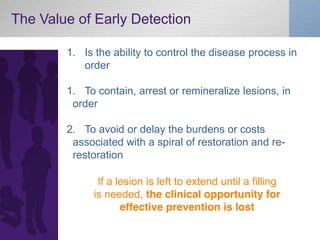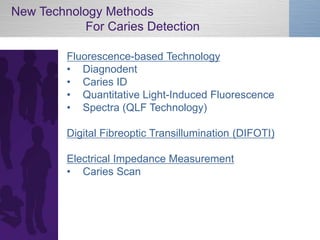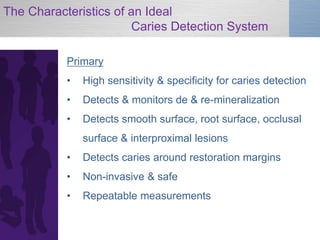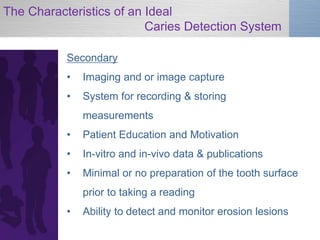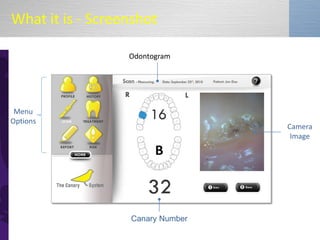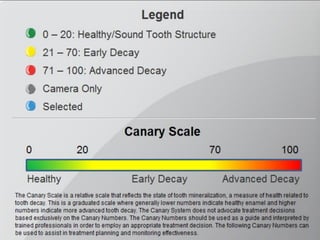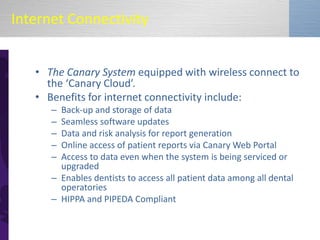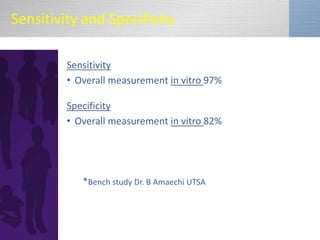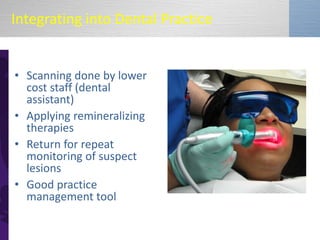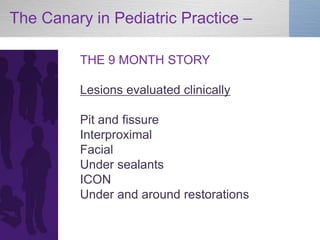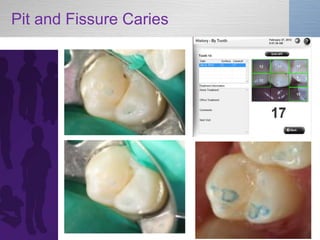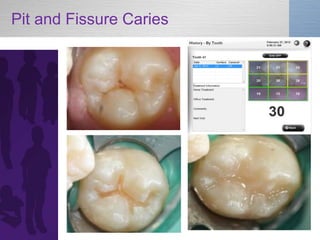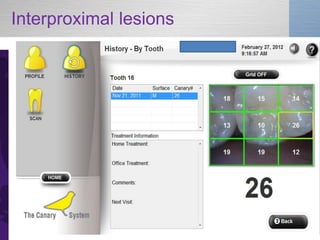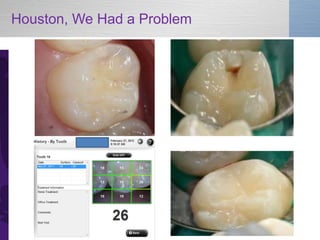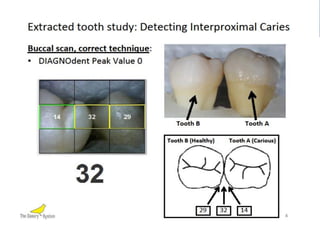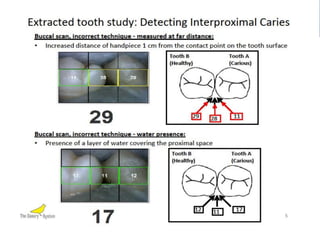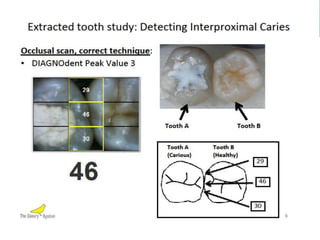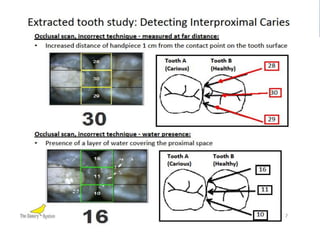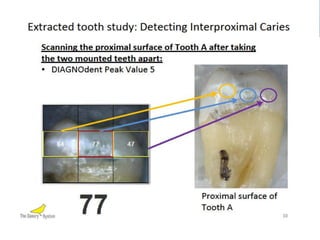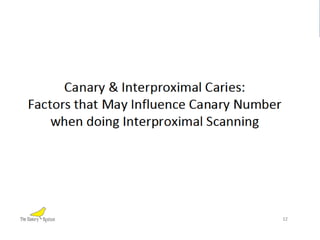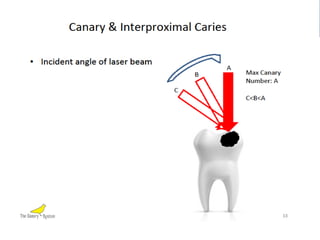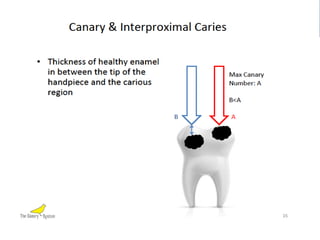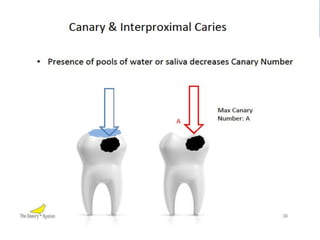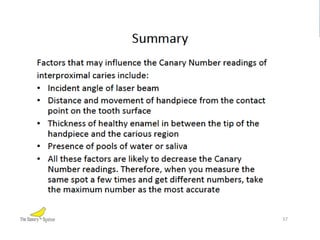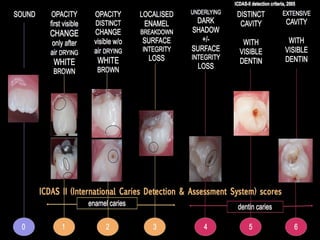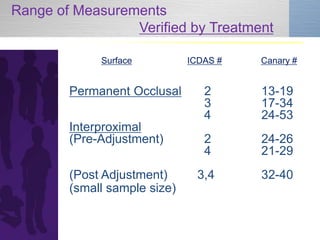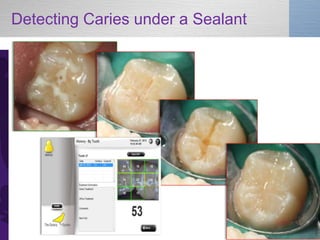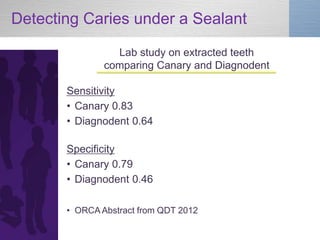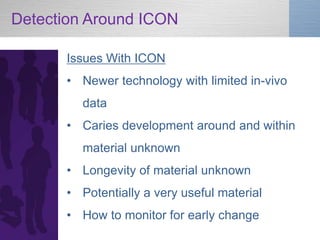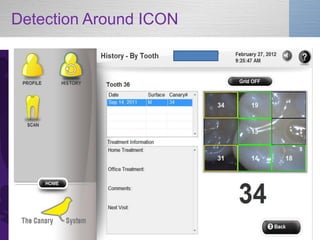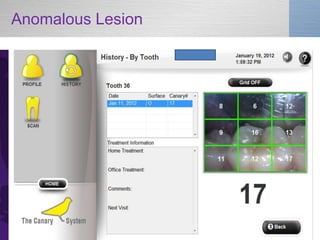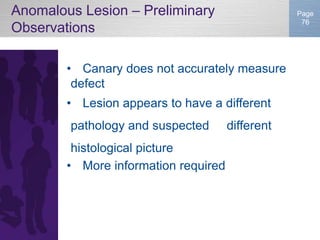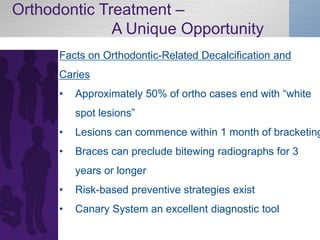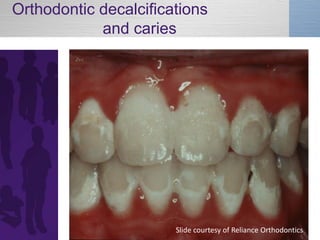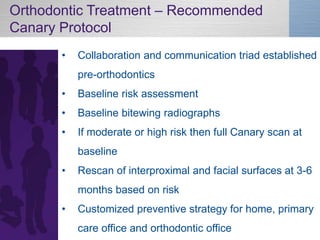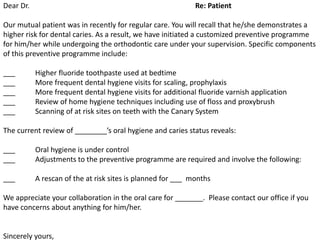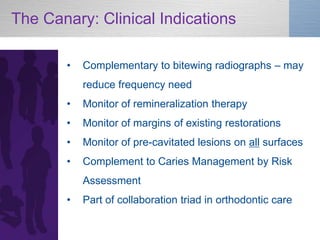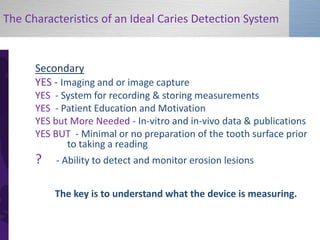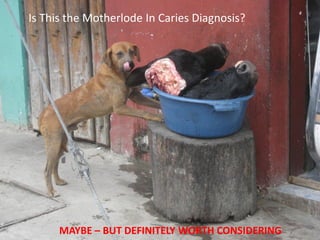New Technologies in Caries Diagnosis: The Canary System in Pediatric Practice
- 1. NEW TECHNOLOGIES IN CARIES DIAGNOSIS The Canary System in Pediatric Practice Dr. Ian McConnachie AAPD Annual Session May 24-27, 2012
- 2. A couple of Gifts from the North
- 3. Disclosures • No Commercial Interest or Reimbursement from Quantum Dental Technologies • Member of Unpaid Dentist Advisory Panel to Quantum Dental Technologies • Some slides provided by QDT
- 4. Acknowledgements Page 4 • DR. STEPHEN ABRAMS President and CEO of Quantum Dental Technologies • DR. MARIELLE PARISEAU Creator of www.ShapingTheFutureofDentistry.org Note: The current final version of this presentation will be available on the Shaping the Future of Dentistry website later this week. Look in Menu under Resources
- 5. New Technologies in Caries Diagnosis • Diagnodent by KaVo • Caries ID by Dentsply • Spectra by Air Techniques • CarieScan by CarieScan Ltd • The Canary System by Quantum Dental Technologies
- 6. Outline of the presentation A Micro Review of Cariology Measuring and Recording Decay - The Current Reality The Shift in Dealing with Decay Newer Technologies Detecting Decay The Canary System Use of the Canary in Pediatric Dentistry – The 9 Month Story Canary-Ready for Prime Time?
- 8. Early Carious Lesion in Enamel
- 9. Pathogenesis of Dental Caries (biological balances) SALIVA PLAQUE PLAQUE ENAMEL ENAMEL Polysaccharides Calcium Salts Plaque buffers mouth inside of tooth SUGARS ACID Calcium Salts Bacterial Enzymes Salivary buffers Demineralization Re-mineralization
- 10. Measuring and recording decay THE CURRENT REALITY • Visual Exam • Mirror and Explorer • Dental Radiographs • Transillumination • Dmfs/dmft
- 11. Methods for Caries Detection Conventional methods • Visual examination: + non-destructive + safe - poor resolution - unable to detect incipient demineralization - unable to detect subsurface caries • X-rays: + non-destructive + can detect subsurface caries - limited safety - unable to detect incipient demineralization - low resolution
- 12. Radiographs • Radiographic imaging of pits and fissures is of minimal diagnostic value because of the large amounts of surrounding enamel . • Literature review by Dove: • “overall the strength of the evidence for radiographic methods for the detection of dental caries is poor for all types of lesions on proximal and occlusal surfaces”. • “it is beneficial only if the intervention is the surgical removal of tooth structure and detrimental if it is used for non-invasive remineralization methods.” McKnight-Hanes C, Myers DR, Dushku JC, Thompson WO, Durham LC. Radiographic recommendations for the primary dentition: comparison of general dentists and pediatric dentists. Pediatr Dent. 1990 Jul-Aug;12(4):212-216 Flaitz CM, Hicks MJ, Silverston LM. Radiographic, histologic, and electronic comparison of basic mode videoprints with bitewing radiography. Caries Res. 1993; 27(1): 65-70. Lussi A, Comparison of different methods for the diagnosis of fissure caries without cavitation. Caries Res 27:409-16, 1993 Dove, S. B., “Radiographic Diagnosis of Dental Caries in Consensus Conference on Dental Caries Management Throughout Life, March 2001, Journal of Dental Education, 2001; 65 (10): 985 – 990
- 13. NO BIG DEAL
- 14. A VERY BIG DEAL Psychological impact Lower body weight
- 15. A TRANSMISSIBLE BACTERIAL INFECTION Caries is a transmissible bacterial infection and a multifactorial disease that reflects change in one or more significant factors in the total oral environment. (NIH Consensus Conference 2001) Diagnosis involves recognition of these changes rather than simply noting cavities
- 16. TOOTH DECAY is PREVENTABLE
- 17. BECAUSE FILLINGS Don’t treat underlying disease Don’t address plaque biofilm issues Don’t change risk level We need to from a surgical approach to a RISK management & preventive approach.
- 18. The SHIFT in Dealing with Decay • Growing awareness of social determinants • Newer recording of caries levels- ICDAS • Risk-based care • A myriad of new products • New diagnostic devices
- 19. “ It is change, continuing change, inevitable change, that is the dominant factor in society today. No sensible decision can be made any longer without taking into account not only the world as it is, but the world as it will be” Isaac Asimov
- 22. Product Decisions? Fluoride • RISK Demand? CPP-ACP (Recaldent) • Age and Ability? NovaMin • Buffering? ProArgin • Fluoride Uptake? Xylitol products Antibacterial rinses • Contact time needed? Salivary products • Desensitization? Neutralizing agents • Antibacterial Activity? Silver Diamine Fluoride • Salivary Stimulant? Povidone Iodine • Compliance? CHX varnish (Prevora) Sealants ICON
- 24. The Value of Early Detection 1. Is the ability to control the disease process in order 1. To contain, arrest or remineralize lesions, in order 2. To avoid or delay the burdens or costs associated with a spiral of restoration and re- restoration If a lesion is left to extend until a filling is needed, the clinical opportunity for effective prevention is lost
- 25. New Technology Methods For Caries Detection Fluorescence-based Technology • Diagnodent • Caries ID • Quantitative Light-Induced Fluorescence • Spectra (QLF Technology) Digital Fibreoptic Transillumination (DIFOTI) Electrical Impedance Measurement • Caries Scan
- 26. The Characteristics of an Ideal Caries Detection System Primary • High sensitivity & specificity for caries detection • Detects & monitors de & re-mineralization • Detects smooth surface, root surface, occlusal surface & interproximal lesions • Detects caries around restoration margins • Non-invasive & safe • Repeatable measurements
- 27. The Characteristics of an Ideal Caries Detection System Secondary • Imaging and or image capture • System for recording & storing measurements • Patient Education and Motivation • In-vitro and in-vivo data & publications • Minimal or no preparation of the tooth surface prior to taking a reading • Ability to detect and monitor erosion lesions
- 28. The Characteristics of an Ideal Caries Detection System The key is to understand what the device is measuring
- 29. Sensitivity and Specificity Sensitivity • The proportion of true positives correctly identified by the test Specificity • The proportion of true negatives correctly identified by the test Therefore, an experimental test aims to achieve 100% sensitivity (no false positives) and 100% specificity (no false negatives) Because these are proportions, can calculate confidence intervals Closer the C.I. is to 1.0 the better
- 31. by Quantum Dental Technologies Canary interactive software and printed patient reports The Canary Console
- 32. Science Behind The Canary System •Pulses of laser light hit the tooth surface. •Tooth glows (Luminescence, LUM) and releases heat (Photo- Thermal Radiometry, PTR). •PTR can provide a depth profile by varying the frequency of the laser beam. Temperature increase < 1oC not harmful •Detected signals reflect the tooth’s condition. •Detects 50 micron lesion up to 5 mm below the surface.
- 33. What it is - Screenshot Odontogram Menu Options Camera Image Canary Number
- 34. Caries Mapping Camera Image with Grid Canary Number
- 36. Canary Patient Report • Customized patient report on dental practice letterhead • Clear simple indication of problem areas • Patient can track their progress • Engages patient in their oral health care
- 37. Internet Connectivity • The Canary System equipped with wireless connect to the ‘Canary Cloud’. • Benefits for internet connectivity include: – Back-up and storage of data – Seamless software updates – Data and risk analysis for report generation – Online access of patient reports via Canary Web Portal – Access to data even when the system is being serviced or upgraded – Enables dentists to access all patient data among all dental operatories – HIPPA and PIPEDA Compliant
- 38. VALUE PROPOSITION Value to the Dentist • Attract new patients: with state of the art technology and a minimally invasive approach • More patient visits: more frequent visits for patients enrolled in remineralization programs • Reduce costs: scans can be performed by lower cost staff (hygienists, assistants) • Affordable: flexible leasing options provide immediate profitability Value to Patients & Insurers • Reduce costly & painful restorations
- 39. The Life Cycle of Tooth Decay Healthy Early Advanced Tooth Enamel Decay Enamel Decay Demineralization Remineralization Remineralization Therapies The Canary System Scan X-Ray, Drill Fill & Bill
- 40. Caries Detection on ALL Surfaces • Between teeth (interproximal areas) • Around the edges of fillings • Enamel and root surfaces Canary detects small lesions • Biting Surfaces from 50 microns in depth and (occlusal pits and fissures) up to 5 mm below the tooth surface.
- 41. Sensitivity and Specificity Sensitivity • Overall measurement in vitro 97% Specificity • Overall measurement in vitro 82% *Bench study Dr. B Amaechi UTSA
- 42. Integrating into Dental Practice • Scanning done by lower cost staff (dental assistant) • Applying remineralizing therapies • Return for repeat monitoring of suspect lesions • Good practice management tool
- 43. The Canary in Pediatric Practice – THE 9 MONTH STORY Our questions at the start • How easy to measure • How reproducible • How accurate • Canary Scale 21-70 • Specificity and Sensitivity
- 44. The Canary in Pediatric Practice – THE 9 MONTH STORY Lesions evaluated clinically Pit and fissure Interproximal Facial Under sealants ICON Under and around restorations
- 45. Pit and Fissure Caries
- 46. Pit and Fissure Caries
- 47. Pit and Fissure Caries
- 48. Pit and Fissure Caries
- 49. Interproximal lesions Issues at Outset • How easy to learn • How reproducible the numbers • Canary Scale 21-70 • Sensitivity and specificity
- 50. Houston, We Had a Problem
- 65. Range of Measurements Verified by Treatment Surface ICDAS # Canary # Permanent Occlusal 2 13-19 3 17-34 4 24-53 Interproximal (Pre-Adjustment) 2 24-26 4 21-29 (Post Adjustment) 3,4 32-40 (small sample size)
- 66. Interproximal lesions The key is to understand what the device is measuring • Canary number will under report lesion size • Intervention decisions remain based on CAMBRA
- 67. Detecting Caries under a Sealant
- 68. Detecting Caries under a Sealant
- 69. Detecting Caries under a Sealant Lab study on extracted teeth comparing Canary and Diagnodent Sensitivity • Canary 0.83 • Diagnodent 0.64 Specificity • Canary 0.79 • Diagnodent 0.46 • ORCA Abstract from QDT 2012
- 70. Detection Around ICON Issues With ICON • Newer technology with limited in-vivo data • Caries development around and within material unknown • Longevity of material unknown • Potentially a very useful material • How to monitor for early change
- 73. Anomalous Lesion
- 74. Anomalous Lesion Characteristics • No surface breakdown (ICDAS 1 or 2) • Evident radiographically, often for a year or longer • Once through enamel you “drop” into defect • Lesion tends to be reddish-brown and “mushy” • Does not exhibit typical carious texture • Suspicion is the histological picture is distinct from traditional caries picture
- 75. Anomalous Lesion
- 76. Anomalous Lesion – Preliminary Page 76 Observations • Canary does not accurately measure defect • Lesion appears to have a different pathology and suspected different histological picture • More information required
- 77. Preliminary Observations on Canary Overall Occlusal Surface • Highest ease of measurement and predictability Facial surface • Highest ease of measurement and predictability Interproximal Permanent Teeth • Significant learning curve • Lesion will be at least as deep as measurement indicates
- 78. Preliminary Observations on Canary (cont’d) Interproximal Primary Teeth • Greater accuracy of Canary number compared to permanent teeth Under Sealants • Very good indicator of what lies beneath ICON • Likely good indicator of change with repeat scans Under and Around Restorations • Good indicator of restoration failure
- 79. Orthodontic Treatment – A Unique Opportunity Facts on Orthodontic-Related Decalcification and Caries • Approximately 50% of ortho cases end with “white spot lesions” • Lesions can commence within 1 month of bracketing • Braces can preclude bitewing radiographs for 3 years or longer • Risk-based preventive strategies exist • Canary System an excellent diagnostic tool
- 80. Orthodontic decalcifications and caries Slide courtesy of Reliance Orthodontics
- 81. Orthodontic Treatment – Recommended Canary Protocol • Collaboration and communication triad established pre-orthodontics • Baseline risk assessment • Baseline bitewing radiographs • If moderate or high risk then full Canary scan at baseline • Rescan of interproximal and facial surfaces at 3-6 months based on risk • Customized preventive strategy for home, primary care office and orthodontic office
- 82. Dear Dr. Re: Patient Our mutual patient was in recently for regular care. You will recall that he/she demonstrates a higher risk for dental caries. As a result, we have initiated a customized preventive programme for him/her while undergoing the orthodontic care under your supervision. Specific components of this preventive programme include: ___ Higher fluoride toothpaste used at bedtime ___ More frequent dental hygiene visits for scaling, prophylaxis ___ More frequent dental hygiene visits for additional fluoride varnish application ___ Review of home hygiene techniques including use of floss and proxybrush ___ Scanning of at risk sites on teeth with the Canary System The current review of ________’s oral hygiene and caries status reveals: ___ Oral hygiene is under control ___ Adjustments to the preventive programme are required and involve the following: ___ A rescan of the at risk sites is planned for ___ months We appreciate your collaboration in the oral care for _______. Please contact our office if you have concerns about anything for him/her. Sincerely yours,
- 83. The Canary: Clinical Indications • Complementary to bitewing radiographs – may reduce frequency need • Monitor of remineralization therapy • Monitor of margins of existing restorations • Monitor of pre-cavitated lesions on all surfaces • Complement to Caries Management by Risk Assessment • Part of collaboration triad in orthodontic care
- 84. Office Integration Recall or Specific Exam Reassess 6 Months •Identify White Spots •Assess Lesion •ICDAS or Measure •ICDAS or Measure •Risk Assessment •Apply Remineralization •Apply Therapy Remineralization •Oral Hygiene Therapy Instruction •Dispense Home- •Provide Home-based Based Therapy Therapy Reassess 3 Months •Assess lesion •ICDAS or Measure •Apply Remineralization therapy •Dispense Home- based therapy
- 85. The Characteristics of an Ideal Caries Detection System - How Does Canary Rate? Primary ? - High sensitivity & specificity for caries detection YES - Detects & monitors de & re-mineralization YES BUT- Detects smooth surface, root surface, occlusal surface & interproximal lesions YES - Detects caries around restoration margins YES - Non-invasive & safe YES BUT - Repeatable measurements The key is to understand what the device is measuring.
- 86. The Characteristics of an Ideal Caries Detection System Secondary YES - Imaging and or image capture YES - System for recording & storing measurements YES - Patient Education and Motivation YES but More Needed - In-vitro and in-vivo data & publications YES BUT - Minimal or no preparation of the tooth surface prior to taking a reading ? - Ability to detect and monitor erosion lesions The key is to understand what the device is measuring.
- 87. Is This the Motherlode In Caries Diagnosis? MAYBE – BUT DEFINITELY WORTH CONSIDERING




